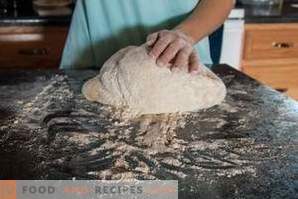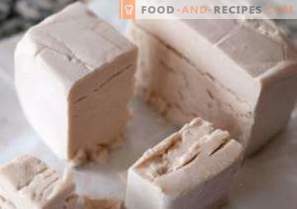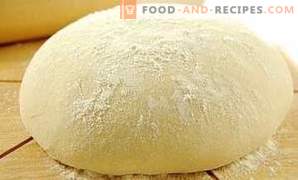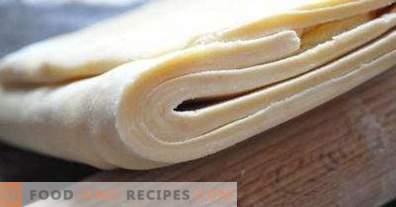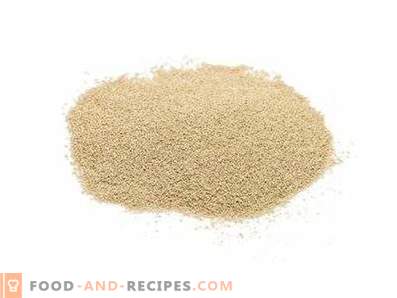
Yeast dough is not simple, working with it requires certain knowledge and skills. Knead and throw in a few days in the fridge will not work. The yeast will die, and the dough itself will sour. What you need to know about it in order to avoid mistakes?
Types of yeast dough
Yeast baking is always lush, porous, if cooked according to the rules. Each product requires its own dough. Blind bagels and bread from the same mass will not work, and not necessary.
The main types of yeast dough:
- Bread - all over the head. It is baked from the most usual dough on yeast with flour and water. Less often, in bread dough sugar and fats are added, but in small quantities.
- Sweet dough. The name speaks for itself. In this test there is baking: sugar, various fats, butter. Often milk, cream, sour cream and kefir are used instead of water. The dough is flavored with vanilla, cinnamon, various essences.
- Puff pastry. It also happens with yeast. Bagels, croissants and other pastries are very lush, light, have a layered structure, contain a large amount of fat.
- Pancake dough or dough for fritters. This dough has a watery consistency, it is intended for frying in a frying pan. Yeast pancakes turn out to be lush, there are many holes in them, and pancakes please them with special tenderness.
Bread and sweet types of dough are very similar to each other in their characteristics, may have the same consistency, differ only in the number of additives. If there is a lot of sugar and fat, it is more difficult for yeast to work. The bread dough will rise faster than the buns.
How to store dough
Yeast time is limited. After the kneading fermentation begins, but it does not last forever. After a few hours the dough begins to sour. For this reason, it is difficult to save for a long time. The exception is yeast puff pastry. It lies perfectly in the freezer and does not lose its properties for several months. Bread and butter dough sometimes also freeze, but the baking quality after thawing sometimes deteriorates, a sour taste may appear.
What you need to know about storing yeast dough:
- If it is not possible to form and bake the product in time, the dough should be removed in the refrigerator. There it will easily stand for up to 24 hours, if this is done immediately after kneading. If the mass is already standing warm and beginning to rise, then it will stand much less.
- Yeast dough dries quickly. It must be kept under a towel or napkin. Sometimes packaged in a package. This can also be done, but we take durable polyethylene. Otherwise, the yeast can just break it.
- A bag or other dish for the dough needs to be lubricated, otherwise it will strongly adhere, it will be difficult to tear off.
The most capricious in storage is liquid yeast dough for pancakes and fritters. It fits very quickly, it is easy for yeast to work with such a consistency. But at the same time the dough quickly sours. After a few hours in the heat it spoils. In the refrigerator rarely worth more than ten hours. Therefore, it is not recommended to knead it for future use, we do it only once, we bake everything at once. But products made from it (pancakes, pancakes, pancakes) are perfectly preserved in the refrigerator, well tolerated by freezing, the subsequent heating in a microwave oven.
Such capricious yeast
Buy good yeast is not always obtained, and sometimes they deteriorate at home. It happens that the products are spent, the dough is mixed, but does not rise at all. Missing pressed (raw, fresh) is immediately visible, they change color, smell, green mold, dark spots can form on the surface.
Missing dry yeast is difficult to determine by organoleptic characteristics.
Outwardly, they can be seen only by the frozen test. It's a shame, a pity, but nothing can be done. Or can it?
How to check yeast:
- Mix the prescription liquid with the specified amount of yeast, add a little sugar and flour, you should get talker.
- Leave in a warm place.
- Check. If a foam appears on the surface, the mass rises, then we introduce the remaining ingredients, boldly knead the dough.
If suddenly the talker has not risen, does not give any signs of life, then we do not spend the rest of the products, you need to run to the store for fresh yeast.
Corroded dough: signs of what to do
The most dangerous thing that happens with yeast dough is that it peroxides. This can be determined by the characteristic smell. If the smell does not work, then you can just look at the mass. The dough will crinkle and “fall off”, the yeast will stop working.
If this happens, you cannot fix it.
An option is to take a portion of the dough for the dough, add sugar, liquids, yeast, flour and other ingredients, knead the new dough.
The second problem is the dough has dried. The crust on the surface forms quickly, it is difficult to soften, the look and taste of baking deteriorates. It is necessary to cover the mixed mass, you can grease with a drop of oil. How to fix? Sprinkle the dough with water or grease, cover, let stand, then stir.
Go
Tricks for good housewives
Let's start with the myths. Everywhere on the Internet and even in educational literature it is written that flour is sifted for oxygenation. Why is there oxygen in the flour if, when combined with a liquid, it gets wet anyway, it sticks together? It is necessary to sift, but in order to get rid of litter and ease the kneading of dough itself, loose flour will more quickly combine with other ingredients.
Useful tips:
- The rise time of the yeast dough is a very relative concept. It depends on a huge number of factors. It is more reasonable to independently check the lift. If, while pressing, the fossa remains for 5 seconds or more, then the dough is ready.
- Yeast dough loves heat. If the room is cool, the bowl can be put on a saucepan with hot water, near the radiator or near the stove.
- All products for mixing must be removed on the table in advance. Let them lie down and get warm, or heat them up specially.
- Pressed yeast is often indicated in the recipe, but they are rarely used now. If needs to be replaced with a dry analog, then reduce the amount by 2.5 or 3 times. You can simply count the flour, on the package with yeast is all the necessary
Yeast dough loves not only heat indoors, but also from human hands. It must be carefully mashed, worked, stroked and do it all only in a good mood. Baking will absorb positive energy, please with pomp and softness.
